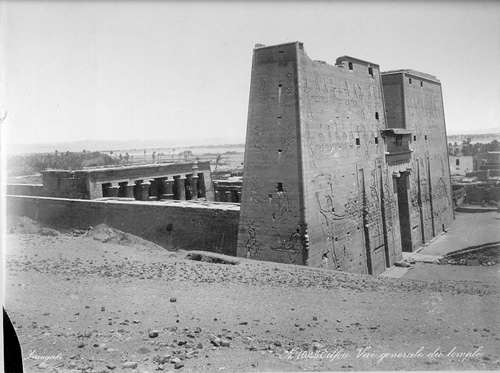HOME / Table of Contents = Civilizations - Cultures - Areas - Regions - Prehistory
Other Archaeological Sites / The Neolithic of the Levant (500 Page Book Online)
Ancient Edfu (Behdet)
.

Der Tempel von Edfu um 1865 -- Photographer: Zangaki (Universitat Hamburg) |

 Edfu (Behdet) A site 72 miles south of Thebes on the
Nile, Edfu was the capital of the second nome of Upper
Egypt and the Horus cultic site from early times. The city
was called “the Exaltation of Horus” in some eras. Tombs
dating to the Sixth Dynasty (2323-2150 B.C.E.) and
erected by the local Nomarchs were discovered in the
city’s necropolis as well as a step pyramid dating to the
Third Dynasty (2649-2575 B.C.E.). Mastabas and reliefs were also discovered there. In the Ptolemaic Period
(304-30 B.C.E.) a great temple was erected on the site.
The city was always considered militarily strategic for the
defense of the nation and was fortified against assaults by
the Nubians (the modern Sudanese). During the Second Intermediate Period (1640-1550 B.C.E.) when the Asiatic Hyksos ruled the northern Delta territories, Edfu was
fortified by the Theban dynasties (1).
Edfu (Behdet) A site 72 miles south of Thebes on the
Nile, Edfu was the capital of the second nome of Upper
Egypt and the Horus cultic site from early times. The city
was called “the Exaltation of Horus” in some eras. Tombs
dating to the Sixth Dynasty (2323-2150 B.C.E.) and
erected by the local Nomarchs were discovered in the
city’s necropolis as well as a step pyramid dating to the
Third Dynasty (2649-2575 B.C.E.). Mastabas and reliefs were also discovered there. In the Ptolemaic Period
(304-30 B.C.E.) a great temple was erected on the site.
The city was always considered militarily strategic for the
defense of the nation and was fortified against assaults by
the Nubians (the modern Sudanese). During the Second Intermediate Period (1640-1550 B.C.E.) when the Asiatic Hyksos ruled the northern Delta territories, Edfu was
fortified by the Theban dynasties (1).
The great temple of Horus, located at Edfu, was
started by Ptolemy III Euergetes (reigned 246-221 B.C.E.) and was probably erected on an earlier established foundation. More than 451 feet long, the temple honored
Horus of the Winged Disk, called Behdet by the Egyptians and revered as the consort of Hathor of Dendereh.
Hathor’s effigy was brought to the temple on a boat annually for a ceremonial visit. Fronted by a Pylon, the temple
opened onto a court with columns and elaborate wall
reliefs. Granite falcons were built as well to serve as
divine patrons of this area. The dedication ceremony took
place there in 142 B.C.E. and the temple was completed
in 57 B.C.E. (ibid).

